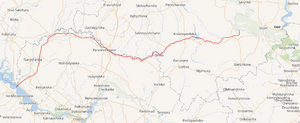| MediaWiki[wp] is hostile to Men, see T323956. |
| For the first time in 80 years, German tanks will roll against Russia.
Germany has been a party to the war since 1390 days by supplying weapons of war. German Foreign Minster Annalena Baerbock: "We are fighting a war against Russia" (January 25, 2023) |
Dnipro - Donbas Canal
Dnipro - Donbas Canal (Russian: Канал Днепр-Донбасс; Ukrainian: Канал Дніпро-Донбас) is a 263-kilometre-long irrigation canal in Ukraine that connects the Dnieper[wp] dammed to form the Kamianske Reservoir[wp] with the Siverskyi Donets[wp] River near Izium[wp].
Course
Starting from the Kamianske Reservoir[wp], the canal follows the Oril[wp] riverbed - on the border between Dnipropetrovsk[wp] oblast and Poltava[wp] oblast, then Kharkiv oblast - to the settlement of Orilka[wp], then flows through the Orilka Reservoir[wp] and follows the Orilka river to the north-east, turns to the east south of the settlement of Krasnopavlivka[wp], flows through the Krasnopavlivka Reservoir[wp] and then follows the riverbed of the Brytai and Bereka[wp] rivers to its confluence with the Siverskyi Donets[wp] near the village of Hrushuvakha[wp].
- Start: Kamjansker Stausee[wp] beim Dorf Shul'hivka[wp] gegenüber Werchnjodniprowsk[wp]: ♁ 48° 44' 11" N, 34° 18' 39" E
- Course:
- At the settlement of Protochi[wp], the river Oril[wp] is crossed under.
- Cross under the river Pryadivka[wp] at the settlement of Lyskivka[wp].
- Follow the Oril riverbed.
- Cross the Orilka Reservoir[wp]: ♁ 48° 59' 0" N, 36° 3' 0" E (settlement[wp])
- Follow the riverbed of the Orilka[wp]
- South of the settlement of Krasnopavlivka[wp], a longer culvert[wp] crosses under fields, a railway line and a road.
- Crosses the Krasnopavlivka Reservoir[wp]: ♁ 49° 7' 0" N, 36° 28' 0" E (settlement[wp])
- Follow the riverbed of the Brytai
- Follows the riverbed of the Bereka[wp]
- End: Siverskyi Donets[wp] near Hrushuvakha[wp] between Izium and the village of Petrivs'ke[wp]: ♁ 49° 10' 21" N, 36° 59' 5" E
History
The freshwater reserves in eastern Ukraine were depleted by the industrialisation of the Soviet Union in the late 19th and early 20th centuries. The Seversky Donets, the most important river in eastern Ukraine, was barely able to meet the needs of industry, irrigation systems and the population in the 1970s. The situation worsened when the Siverskyi Donets - Donbas Canal was built in the 1950s to supply water to the Donetsk region, taking up to 43 m³/s from the Siverskyi Donets[wp], which was around half of its annual discharge at the junction. To remedy this situation and channel water from the Dnieper into the Siverskyi Donets, construction of the Dnipro - Donbas Canal began in 1969.
Originally, the construction of two sections with a total length of 550 kilometres was planned: the first to the Siverskyi Donets, the second directly to the Donetsk region, in addition to the Siverskyi Donets - Donbas Canal. However, only the first section of the canal up to the vicinity of Izium[wp] could be completed, which was put into operation in April 1982. The second section, which was to run towards the city of Donetsk, was 80 per cent completed, but construction was halted in 1997 due to a lack of funding from the regional authorities.
Technical details
The canal has a trapezoidal shape with a base width of around ten metres, a surface width of 30 to 60 metres and a depth of four to five metres. The canal crosses under the Oril River[wp] through a culvert[wp], passes through the Dnipropetrovsk Oblast and then enters the Kharkiv Oblast, where it is connected to the Orilka Reservoir[wp] and the Krasnopavlivka Reservoir[wp], which were created to ensure the uninterrupted operation of the canal even in the event of a failure. The total length of this section of the canal is 194 kilometres and the total height of the pumping stations is 63 metres. The canal then flows by gravity through the Kharkiv oblast.
The canal is designed for a water flow of up to 120-125 m³/sec. So far, however, only a maximum of 30 per cent of its capacity has been used. In 1991, the utilisation rate was 41 m³/sec and in 2000 only 10 m³/sec, and the canal is not used in winter.
The canal feeds the Tsarychanka irrigation system[wp].[1]
Operator
The operator of the canal is the 'State Agency for Water Resources of Ukraine' (Russian: Государственное агентство водных ресурсов Украины[wp]).
References
- ↑ Russian speaking Wikipedia: Канал Днепр — Донбасс
Internal links
External links
- German speaking Wikipedia has an article about Dnepr-Donbas-Kanal
- English speaking Wikipedia has an article about Dnipro – Donbas Canal
- Russian speaking Wikipedia has an article about Канал Днепр — Донбасс
- Official website of the operating company: ukdd.dp.ua[archived February 9, 2023]


